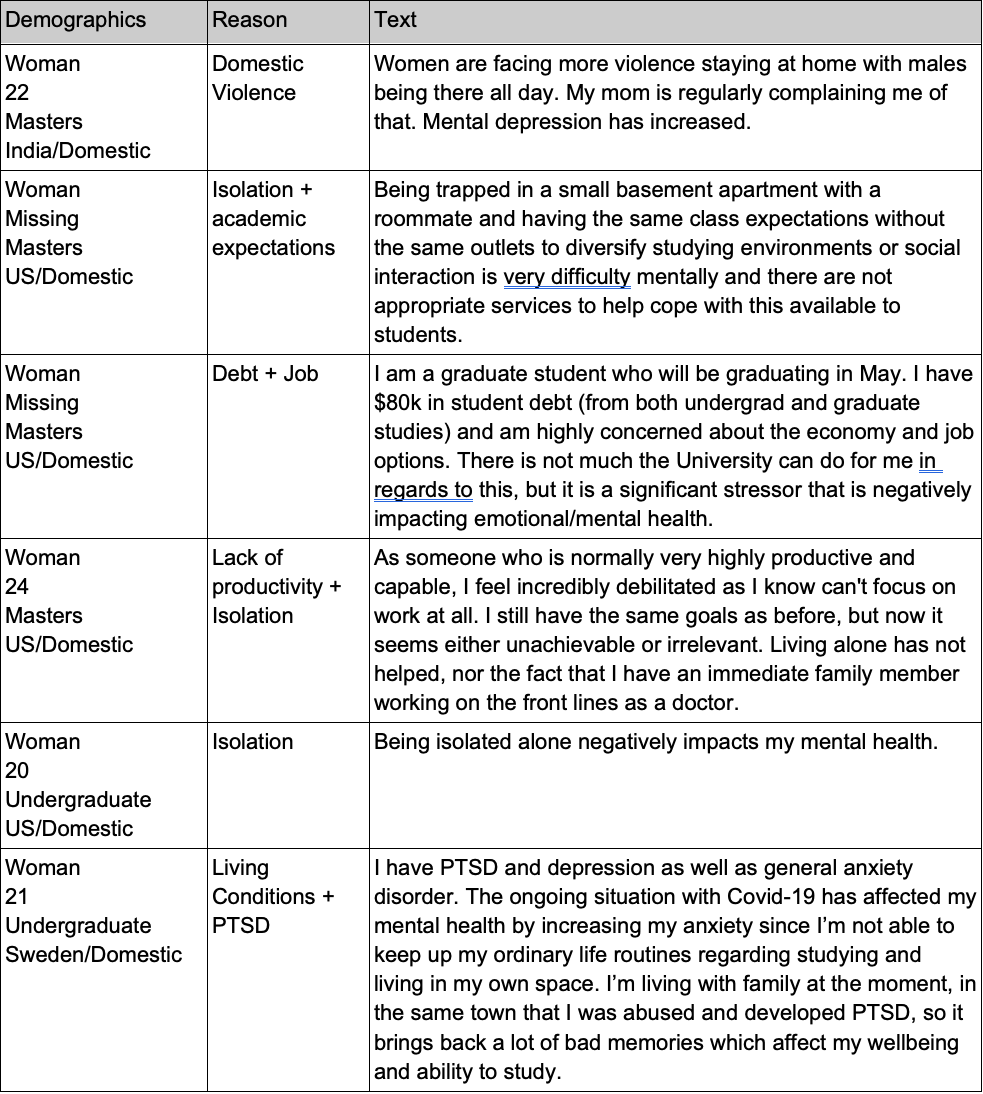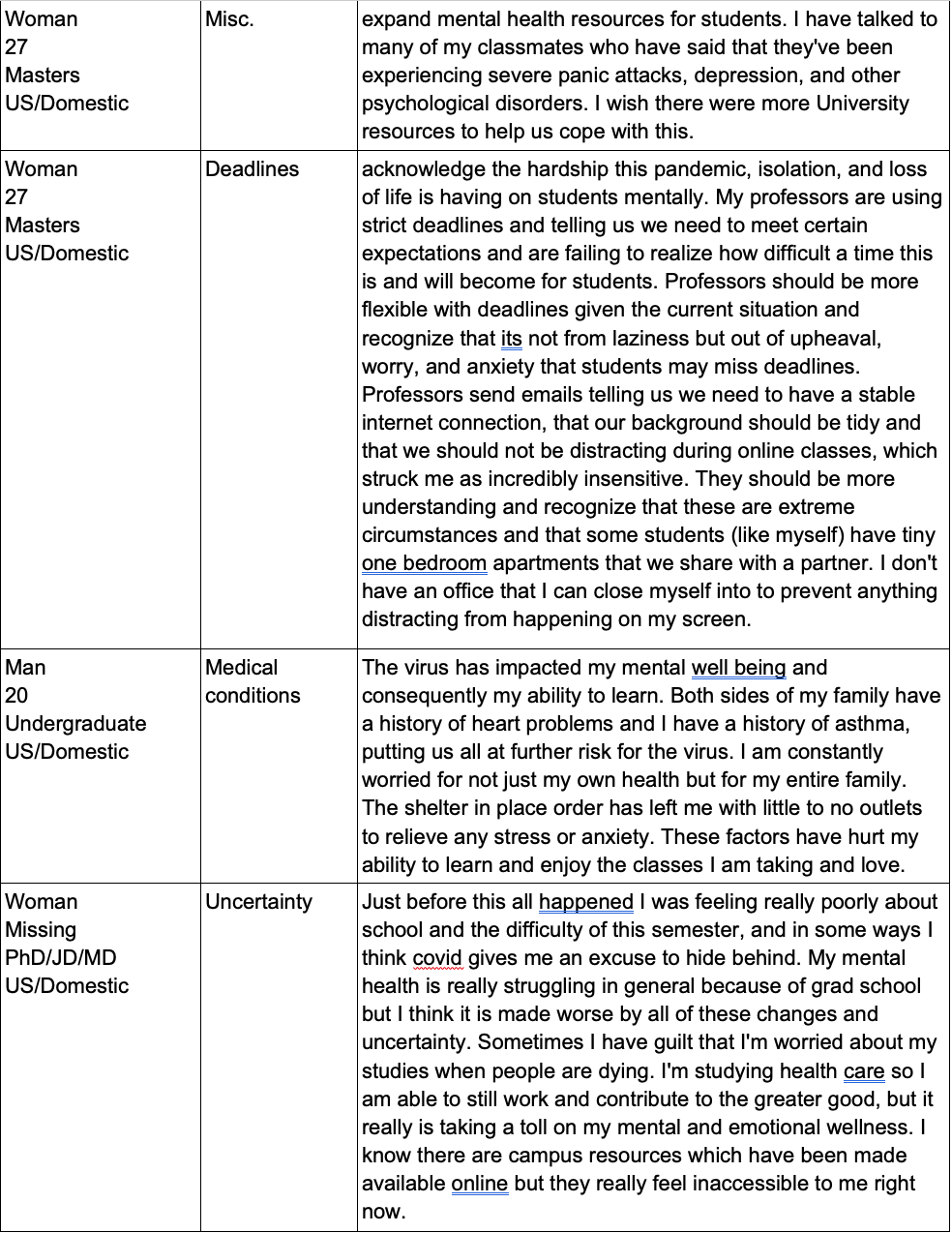Movement restrictions and campus closures as a result of the Covid-19 pandemic have dispersed students and faculty to multiple locations, breaking our usual channels of communication. While individual universities and faculty members have all reached out to their own students, it has been harder to contextualize our own students’ experiences within a broader framework of campus closures and general disruption.This short essay describes the early experience with an online survey questionnaire, designed to address this gap, by a team at Georgetown University’s gui2de network. The questionnaire was designed collaboratively with students and faculty members at multiple institutions and then sent through word-of-mouth advertising to faculty and students worldwide. We focus here on how the questionnaire is working as a tool to aggregate student experiences and highlight some results from the 516 responses received during the first week of implementation. Readers are invited to visit our website where up-to-date live results are displayed on a dashboard.
Survey Process
The rapid-response Covid-19 Student Impact Survey was designed as an opportunity for students to share their stories and current situation, while balancing four key needs:
● Privacy. Students should be able to confidently respond describing their circumstances without any possible risk.
● Shareability. Institutions should be able to evaluate the needs of their own students and the responses of other institutions.
● Basic standardization. We should be able to summarize common situations and generalizable impacts within and across groups of respondents.
● Diversity of experiences. As the contours of this situation remain hazy, the questionnaire was also designed for students to share their specific stories, which could help us better understand the varying and unforeseen situations and needs among respondents.
To satisfy these goals, we developed a short, anonymous online survey using gui2de’s already-procured survey platform that included both simple and multiple-choice responses alongside longer free-text fields. In consultation with other academics and the support of the IRB, we made deliberate decisions to exclude important information that may be potentially identifying to any user of the information, including direct questions about individuals’ health status. We also made every question optional, including the decision to identify the individual’s home university or current location.
On March 26, 2020, the gui2de team from Georgetown University launched the Covid-19 Student Impact Survey. By March 29th, the study was available in Arabic, English, French, Hindi, Italian and Spanish, with Swahili and German currently forthcoming. The official information page for the study, including the link to the survey, the questionnaire, the live results dashboard and more information can be accessed at this link.
Description of Response
At the time of writing, using data collected between March 26 and March 31, the survey had 516 respondents from twenty-eight countries. Only four individuals declined consent or indicated they were not over the age of 18 and therefore did not complete the survey. Most of those who responded (380) were currently attending institutions located in the United States and 30% of all respondents (27% of US-institution respondents) were international students. Responses were equally split between undergraduates (33%), masters-level students (38%), and doctoral or other students (29%). The median respondent spent eight minutes with the survey, and 75% spent less than fifteen minutes.
As the survey was distributed and completed electronically, relying on direct communications from faculty whom we were able to reach personally or through social media, the responses, thus far, are from a relatively selective group of students and do not represent the general student population: they have some degree of connection to staff at relatively elite American universities and continued access to high-quality or mobile Internet.
More specifically, our responses have come from students whose campuses have closed (98%), but who were currently living or staying on campus or in the same city (62%), either with friends or roommates (30%), alone (18%) or with family (52%). Of those living with family, 21% reported living with someone considered “at-risk” for Covid-19. Our respondents were more likely to be women (66%) and, of the 435 who volunteered information about their age, 34% were aged 22 or under, 31% were aged 23-27, and 30% were aged 28-32. It is therefore likely that, at the time of writing, the survey has not reached students who have dispersed back to their original domiciles.
Responses to the questionnaires have been complete and thorough and we were able to identify only three responses as obvious malicious spam, and one respondent whose free-text responses could lead to their identification without further anonymization. The high quality of the data allows us to rapidly release the quantitative responses and, after a round of further anonymization, the micro-data including free-text responses and institutional affiliation. Summary statistics of the quantitative data are automatically updated live on the dashboard published on the study website.
We had anticipated that our respondents would not constitute a random sample of students and therefore the quantitative data would not provide a representative picture of students’ experiences. Therefore, we had allowed for free-form additional comments to every section, allowing a variety of experiences to emerge through the survey. Our original understanding was that students would use these free-form boxes to share their stories. Although we do not have readily available comparisons with other surveys, our original impression is that the free-form responses have not been as widely used as had envisioned: both the placement of these questions (at the bottom of every page) and the likelihood that some students filled up the questionnaire on their phones or mobile devices might have inhibited longer responses to these questions. Table 1 shows, for instance, that the average free-form response consisted of thirty-two words, and free-form responses invited later in the questionnaire elicited fewer attempts and shorter answers.
Table 1: The use and length of freeform responses in the COVID-19 Student Survey
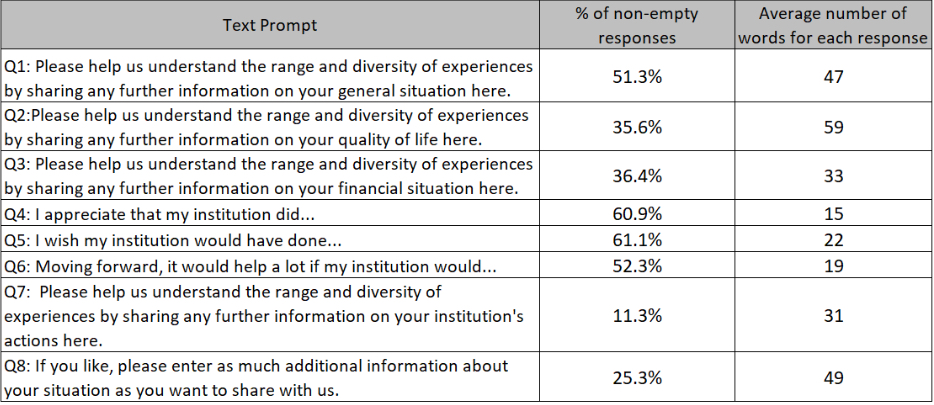
Notes to Table 1: Response rate and length of free-form text responses submitted between March 26 and March 31. Three observations were removed after being flagged by a student reviewer as malicious spam. Average word count for each response was calculated using only non-empty responses.
Early FindingsThe relative completeness of the quantitative responses allows us to describe some early patterns, which we complement with quotes from the free-form responses. Figure 1 shows that, of the 479 respondents who completed a question on their psychological wellbeing, 364 (79%) reported feeling “much worse” or “worse” than before. Worse mental health could arise from multiple causes, including general feelings of anxiety amid the uncertainty and stress of the pandemic; for instance, more than 80% of students are concerned about their immediate future (the next month and the summer). It could also reflect specific changes to the students’ own situation, and we have shown three different factors that could be at play in the bottom panels of Figure 1.
First, 78% say that their ability to pursue their academic goals (including, potentially, graduating) is now worse or much worse. Concerns range from more immediate concerns about graduation, online classes and examinations to problems with how to continue research for graduate students.
Second, the pandemic appears to have taken a toll on access to healthcare: 40% say that their access to healthcare was worse or much worse now compared to before the crisis. Since very few (5%) report themselves to be in medically imposed quarantine, this suggests that it has become hard for students with underlying medical problems to continue accessing care.
Figure 1: How have students experienced change since the start of the pandemic
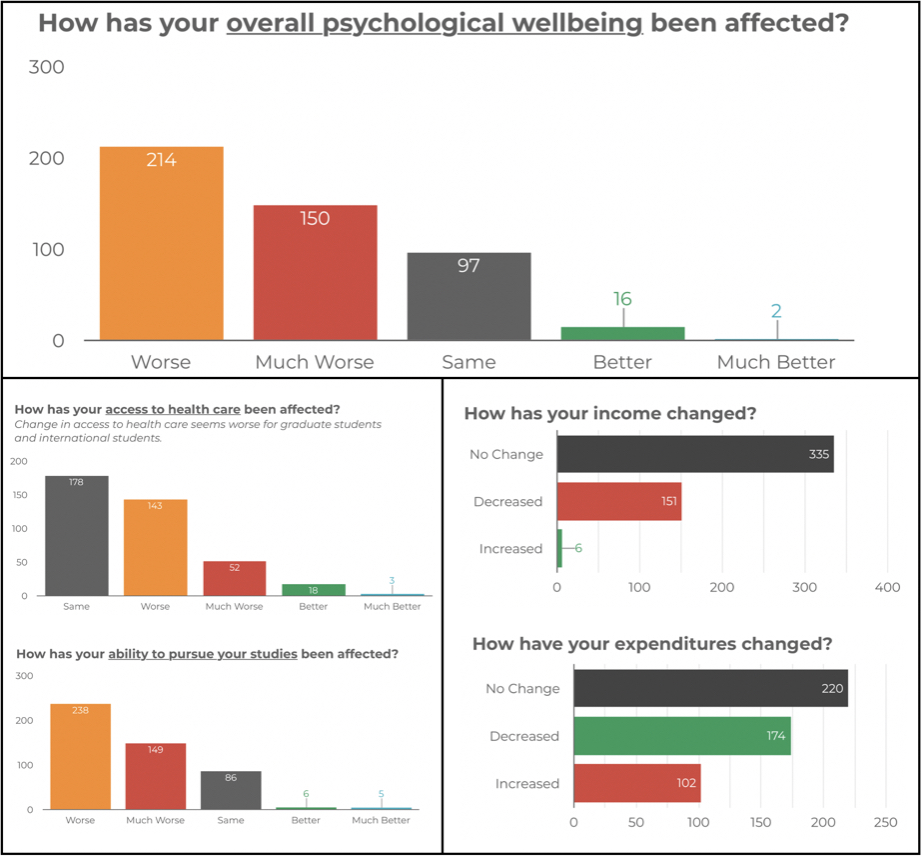
Notes to Figure 1: Bar graphs for questions in the survey regarding psychological well-being, access to health care, income and expenditures. 516 responses were collected between March 26 and March 31, and 5 were excluded due to refusing consent or not of age of consent. Missing responses & N/As were ignored for these graphs.
We should emphasize that the majority of the respondents continues to live in the same city that their university is located in, so that worsened access to healthcare does not (only) reflect geographical distance from their usual sources: 40% of respondents who remain in the same city as their institution, for example, report worse or much worse access to health care, as do 35% of those who report remaining on their own campus (this compares to 34% of those in a different city, and 50% of those in a different country). We also note that access to healthcare seems to have deteriorated more for graduate students (masters and PhD) than for undergraduates, as about half of undergraduates reported having same or better access while 44% of graduate students reported it to be worse or much worse.Selected free-form responses highlight stories behind the marked deterioration in their mental health:
● Example 1: A woman who is 21 years old and has moved away from campus writes: “I have a toxic household and am suicidal when I stay at my mom’s house. I have had to stay with my boyfriend’s family.”
● Example 2: A woman who is 25 years old writes about her continuing problems with anxiety: “I suffer from anxiety even before the Covid-19 and right now I have managed to keep it away by mostly work-avoiding and procrastinating major tasks that would make obvious the change in circumstance. I have for instance avoided applying for summer internships because I don’t want to have to deal with the rejection or other related challenges which might exacerbate my anxiety.”
● Example 3: A 20-year-old man writes about his asthmatic pre-condition: “The virus has impacted my mental well-being and consequently my ability to learn. Both sides of my family have a history of heart problems and I have a history of asthma, putting us all at further risk for the virus. I am constantly worried for not just my own health but for my entire family.”
Mental health also comes up prominently in free-form responses on what institutions can do better, with several students urging universities to expand their support. Free-form responses suggest, in one case, a reduction in available resources (“My university has reduced the availability of mental health services including cancelling free group therapy”) and there are clear pleas for help: “Expand mental health resources for students” and “Help us out with our mental health.”
We should note that there are also a minority of respondents who felt that campus closures were beneficial for their mental health. While this is rare, it does suggest that the reaction to this pandemic may differ remarkably across people.
• Example 1: A 57-year-old woman who is an introvert writes: “I am an introvert: it is during my ‘normal’ life that I experience anxiety and depression (when most people may not). In a time of crisis of that scale, everything is leveled and I do quite well with external restrictions. The pressure to perform according to normal standards has eased quite a lot for me and I am currently feeling strong and less anxious. I understand this may not be the common reaction!”
• Example 2: A man who is 32 years old writes about having extra time for studies and sports: “I’m an introvert so being on my own most of the time does not worry me or makes me feel depressed. Since I no longer have to commute to university and have no time gaps between the lectures, I can actually save much time for useful activities as preparing or revising my studies and do some sport.”
Third, the bottom right panel of Figure 1 shows that financial circumstances have changed. Encouragingly, only 6% report that their financial aid has been reduced (ranging from a few hundred dollars to $10,000) and only 10% expected to take on more total debt this semester (not reported). However, expenditure and income patterns appear to have changed in very diverse ways. While 75% of respondents reported that their expenditures would remain the same or would decline, 20% anticipated higher overall expenses and an additional 31% anticipated lower incomes over the semester. Among those who believe that their incomes will be lower, the average decline was $2,200, although, again, these numbers can vary with one respondent estimating a loss of $50,000 and several more estimating losses between $10,000 and $20,000. Or particular concern are the 8% of respondents who anticipated both a loss in income and an increase in expenditures, with the average such student anticipating an income loss of $930 and additional expenditures of $1,475, creating significant unexpected financial gaps for many students.
Finally, respondents also raised concerns regarding assignments, exams and deadlines. Most of the learning has moved online and students are asking for greater flexibility around issues of grading and teaching. For instance, one student writes:“Professors send emails telling us we need to have a stable internet connection, that our background should be tidy and that we should not be distracting during online classes, which struck me as incredibly insensitive. They should be more understanding and recognize that these are extreme circumstances and that some students (like myself) have tiny one bedroom apartments that we share with a partner.”
We have not yet systematically analyzed the free-form responses, but to provide some idea of what these responses refer to, we have created a word cloud in Figure 2, where larger words are those that are used more frequently (after removing common words, such as articles) in these responses. We have also provided a table of selected responses in the Appendix that highlights how the students’ situations at home has intersected with the disruption from the pandemic. As Figure 2 shows, there are significant concerns about jobs, research completion and travel as well as students’ future plans and graduation, but there is also great diversity in the issues that students have raised. Some are concerned about their situation at home, others about funding, international students are worried about their visas and there is a general concern about health. The quotes in Appendix Table 1 suggest that student’s circumstances differ, and therefore may require a variety of active responses from universities.
Figure 2: A word-cloud from free-form responses
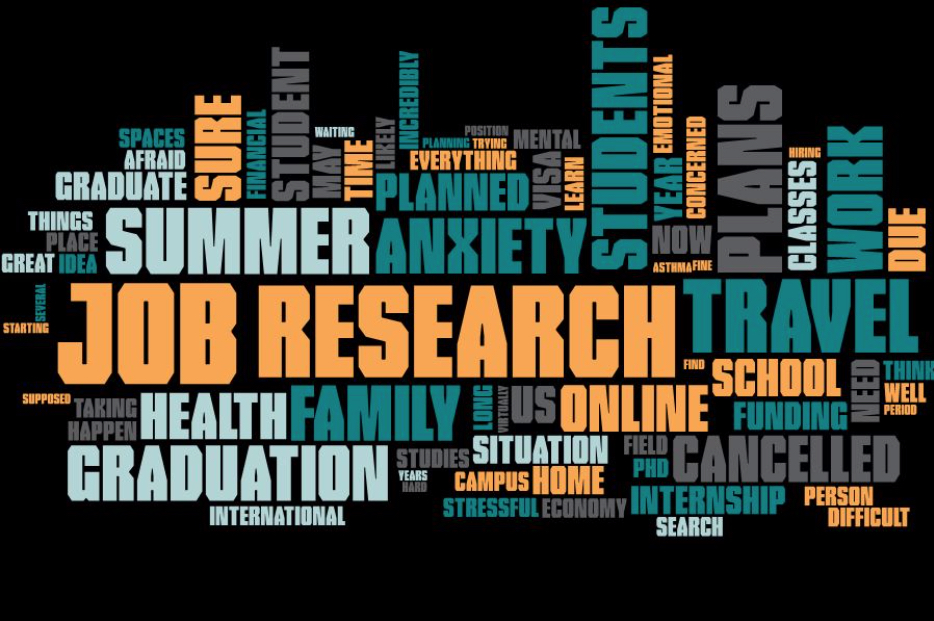
Concluding thoughtsModern survey technologies and workflows have made it possible to rapidly develop and deploy online questionnaires that allow for a diversity of responses. As is well understood, these kinds of surveys are not representative of any group of students and we cannot observe the situations facing some of the most vulnerable potential respondents who we cannot reach with the survey through digital means. Nevertheless, this exercise may be worth expanding as the broad tools required for such surveys can be rapidly deployed1. In particular, the combination of standardized responses with free text, might allow us to (a) detect hardships and situations that we did not anticipate; and (b) characterize the scope and scale of those that we could anticipate.
We offer two concluding thoughts.
First, the university experience—especially in the U.S.A. where many students live either on campus (or close to it)—allows students and administrators to abstract from their students’ diverse backgrounds. Access to resources, libraries and healthcare is far more uniform once students are physically located on campus. The Covid-19 pandemic has forced campuses to close, bringing to light that students who are currently enrolled come from many different backgrounds, with home conditions that can make it very difficult to pursue their academic ambitions. The difficulties they face are incredibly diverse, and addressing these issues will require great innovation and imagination among university administrators and faculty.
Second, surveys such as these can be a powerful communication tool for students. As many students expanded on their increased stress and the overload of information they received, they expressed gratitude towards the opportunity to share information back and have their voice heard. Some universities’ leadership reached out to find ways to use the tool to create a space for students to share their experiences with administrations and with each other, and for students to know they are not alone. In the coming days, we will be welcoming any collaboration proposals from universities wanting to offer a platform for their students.
Appendix Table 1: Selected sample of free-form responses.
Notes: Demographics column includes gender, age, degree, institution country and nationality status of each respondent (where available) The tags in “Reason” column describe the different themes discussed in the free-form texts.
